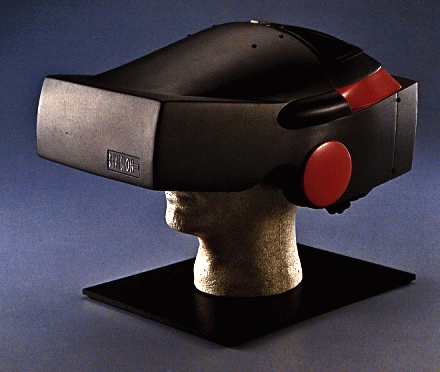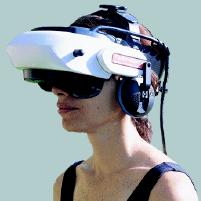Head-Mounted Display (HMD)
 |
 |
|
UP : Modern inexpensive HMD: The General Reality CE-200W. (Photo: General Reality Corp.) |
-
Two miniature displays
-
Two image pipelines
-
A motion tracker
The head-mounted display (HMD) was the first device providing
its wearer with an immersive experience. Evans and Sutherland demonstrated a
head-mounted stereo display already in 1965. The EyePhone from VPL Research
was the first commercially available HMD (1989).
A typical HMD houses two miniature display screens and an optical system that channels the images from the screens to the eyes, thereby, presenting a stereo view of a virtual world. A motion tracker continuously measures the position and orientation of the user's head and allows the image generating computer to adjust the scene representation to the current view.
As a result, the viewer can look around and walk through the surrounding virtual environment.
Issues : Heavy
Consider carrying two displays around on your head.
+ Stereopsis is a strong
3D queue
+ Existing Technology
+ Personal Display
- Obtrusive
- Narrow FOV
(Tunnel Vision)
- Low Resolution
- Tracking
Currently the most popular 3-Dimensional (VR) display
What is the best way to get steroscopique view of two scenes : it is by giving one differente image to each eyes
To overcome the often uncomfortable intrusiveness of a head-mounted display, alternative concepts (e.g., BOOM and CAVE) for immersive viewing of virtual environments were developed.